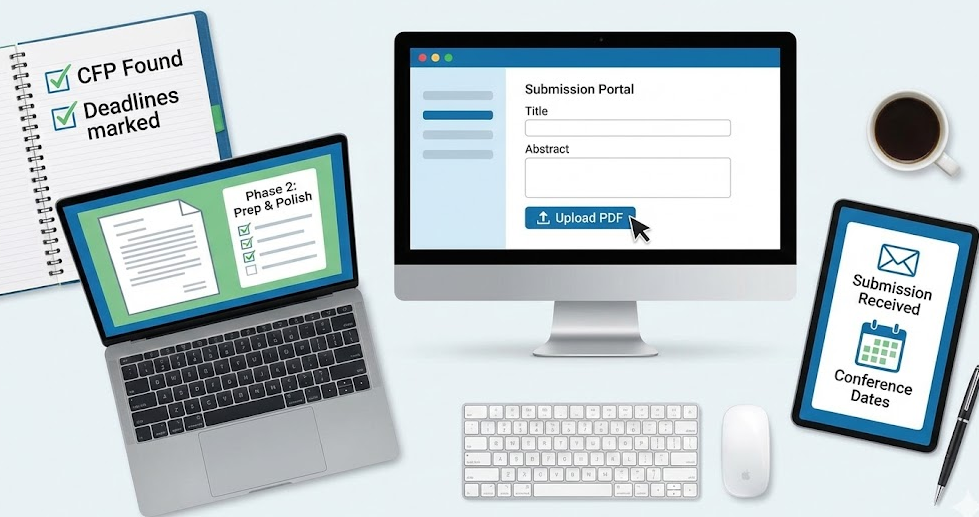

6 views||Release time: Nov 25, 2025
Before you write the final draft, you need to know exactly where you are aiming.
The CFP is the conference’s official invitation. It contains every rule you need to follow.
Where to find them: Ask your advisor/supervisor (they know the best venues), check professional society websites (IEEE, ACM, etc.), look at where the papers you cited were published, or use aggregators like WikiCFP.
Verify the Scope: Read the list of topics in the CFP carefully. If your paper is about deep learning for medical imaging, don't submit it to a general conference on theoretical physics unless they have a specific track for it.

Conference deadlines are almost always strict. Put them in your calendar immediately.
Abstract Deadline: Some conferences require you to submit just the title and abstract a week before the full paper. If you miss this, you cannot submit the paper later.
Full Paper Deadline: The final moment you can upload the PDF. Note the timezone! "Anywhere on Earth" (AoE) is a common deadline timezone that buys you extra hours.
As a beginner, you are a target for "predatory conferences." These are fake events designed to steal your registration fee.
Red Flags: They spam your email with flattering invitations; the topics are wildly broad (e.g., "Conference on Science, Engineering, and Medicine"); they guarantee acceptance; the website looks unprofessional and lists no well-known professors on the committee.
Green Flags: Your advisor recommends it; it is sponsored by a major professional society (IEEE, ACM, Springer, etc.); it has a clear history of previous annual events.
You have the paper written, but it’s not ready to submit until it follows the rules.
Conferences do not accept generic Word documents. You must use their official formatting template.
Download the template (usually LaTeX or Word) from the conference website.
Do not alter the margins, font sizes, or spacing to squeeze more text in. This is grounds for immediate "desk rejection" (rejection without review).
Respect the page limit strictly (e.g., "8 pages plus references").
This is the most common trap for beginners. You need to know how the reviewers will see your paper.
Single-Blind: The reviewers know who you are, but you don't know who they are. Action: Keep your names and affiliations on the paper.
Double-Blind (Most Common in CS/Engineering): Neither side knows the other. Action: You must anonymize your paper.
Remove author names and affiliations from the title page.
Do not write "As we showed in our previous study [1]..." Instead write "As Smith et al. showed previously [1]..."
If linking to GitHub or data, use an anonymous repository service.
Never submit a paper without explicitly asking every person listed as a co-author for their final approval. They need to see the final PDF that is being uploaded.
Do not wait until 11:55 PM to start this process. The submission systems (like EasyChair, HotCRP, or Microsoft CMT) can be confusing and slow down under heavy traffic near the deadline.
Go to the submission URL listed in the CFP a few days early and create your account.
When you click "New Submission," you won't just upload a PDF. You have to fill out a form. Have this info ready in a text document to copy-paste:
Title & Abstract: Exactly as they appear in the paper.
Author Info: Names, emails, and affiliations for every co-author in the correct order.
Keywords/Topics: You will usually select checkboxes or enter keywords. Choose carefully. This is how the system matches your paper to the right expert reviewers. If you choose wrong, you might get a reviewer who doesn't understand your sub-field.
Conflicts of Interest (COI): You may have to list people who shouldn't review your paper (e.g., your advisor, recent collaborators, or colleagues at your same university).
Upload your final PDF.
The system might check the file size or format automatically. If it throws an error, you need time to fix it.
Once you hit submit, you should receive an automated email within minutes. If you don't get an email, your submission might not have gone through. Check your spam folder, then check the portal again.
Your paper is assigned to a "Program Committee" member, who assigns it to 2–4 reviewers. They will read it and score it over the next 1–3 months.
Some conferences offer a "rebuttal" or "author response" period. You will see the reviewers' comments before the final decision. You have a few days to write a polite, succinct response to clarify misunderstandings or defend your choices.
You will eventually get an email with the subject line "Notification of Acceptance."
Scenario A: Rejection. It hurts. It happens to everyone, even professors. Allow yourself to be sad for a day. Then, read the reviews calmly. Even if they seem harsh, there is usually valuable feedback. Revise the paper and submit it to a different conference. Never waste a good idea.
Scenario B: Acceptance! Celebrate! But you aren't done. You now have to:
Address required reviewer changes.
De-anonymize the paper (add names back in).
Submit the final "Camera-Ready" version by a new deadline.
Register for the conference (at least one author usually has to pay to attend and present).
[ ] Did I verify this is a legitimate, non-predatory conference?
[ ] Is the topic actually within the scope of the CFP?
[ ] Did I use the correct conference template without altering margins?
[ ] Did I check if it is double-blind and anonymize if necessary?
[ ] Did all co-authors see the final PDF and agree to submit?
[ ] Did I create my submission portal account days before the deadline?
[ ] Did I receive the confirmation email after uploading?